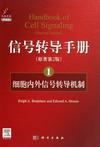信号转导手册
2011-6
科学出版社
布拉德肖
384
Ralph
A.Bradshaw编著的《信号转导手册(1细胞内外信号转导机制原著第2版导读版)(精)》包含350个章节,全面涵盖细胞信号转导领域。内容包括:细胞内外信号转导机制,蛋白质磷酸化和去磷酸化,钙离子信号转导、脂质介导的第二信使,蛋白质互作、环化核苷酸,G蛋白、发育生物学中的信号转导,转录与翻译:细胞核与细胞质事件.细胞内功能区隔信号转导、胞间和细胞基质问的相互作用、疾病病理学。
《信号转导手册(1细胞内外信号转导机制原著第2版导读版)(精)》是生物学实验室不可或缺的工具用书,适用于生物化学与分子生物学、细胞生物学等相关专业的高年级本科生、研究生.也可作为教师的教学和科研参考书,亦可供生物医学、药理学、免疫学及相关领域的研究人员参考。
英文目录
撰稿人名单
第二版前言
第一版前言
导读版第①卷 细胞内外信号转导机制
l.细胞信号转导:昨天、今天和明天
第一部分 起始:胞外及质膜事件
A 分子识别
2.分子识别的结构和能量基础
3.蛋白与蛋白相互作用的自由能概貌
4.分子社会学
5.抗原一抗体识别及其构象变化
6.抗原一抗体界面处的结合热力学
7.免疫球蛋白-Fc受体相互作用
8.免疫球蛋白超折叠及其在分子识别中的多种用途
9.T细胞受体/pMHc复合体
10.细胞表面黏附受体的机制特征
11.免疫突触
12.NK受体
13.碳水化合物的识别与信号转导
14.鼻病毒与其受体的相互作用
15.卜型人免疫缺陷病毒与其受体的相互作用
16.流感病毒神经氨酸酶的抑制剂
17.涉及血液纤维蛋白原及纤维蛋白的信号事件的结构基础
18.整合素信号的结构基础
19.G蛋白异源三聚体及其复合物的结构
20.G蛋白偶联受体的结构
21.Toll样受体的结构与信号
22.多种多样的淋巴细胞受体
B 多通路受体
23.G蛋白偶联受体的结构与功能:从最近发现的晶体结构得到的启示
24.趋化因子及其受体的结构与功能
25.G蛋白偶联受体的结构及其被可扩散激素所激活的过程(参照β2型肾上腺素受体模型)
26.蛋白酶激活的受体
27.由激动剂导致的G蛋白偶联受体的脱敏及细胞内吞化作用
28.由G蛋白偶联受体形成的二聚化复合体的功能
29.细菌中的趋化性受体:跨膜信号,敏感性,匹配及受体聚集
30.离子通道结构概论
31.STIM和Orai介导的钙库依赖性钙信号及CRAC离子通道激活的分子机制
32.离子渗入性:离子选择性与进入阻断的机制
33.烟碱乙酰胆碱受体
34.与核苷酸环化酶直接结合而被调节的离子通道
C 对受体的横向比较研究
35.细胞因子受体概述
36.生长激素与泌乳激素家族及其受体:受体激活和调节的结构基础
37.以促红细胞生成素受体为例的细胞因子信号
38.纤维原细胞生长因子(FGF)信号复合体
39.γ干扰素及其受体的结构
导读版第2卷 蛋白质磷酸化和去磷酸化
导读版第3卷 钙离子信号转导、脂质介导的第二信使
导读版第4卷 蛋白质互作、环化核苷酸
导读版第5卷 G蛋白、发育生物学中的信号转导
导读版第6卷 转录与翻译:细胞核与细胞质事件
导读版第7卷 细胞内功能区隔信号转导、胞间和细胞基质间的相互作用、疾病病理学
索引
Mechanistic Features of Cell-Surface Adhesion Receptors Living cells constantly interact with their environment.Asa consequence,a number of sensory systems have evolvedfor the collection,processing,and integration ot a remark-able range of environmental stimuli arising from cell-celland cell-substrate interactions.For instance,developmentaland morphological processes in higher eukaryotes rely onthe orchestrated migration of cells in response to specificphysical and chemical cues;T cell activation relies on thelocalization and comDartmentalization of cell-adhesion andsignaling molecules;and adherent cells must respond to avariety of intracellular and extracellular mechanical forces.All of these processes rely on the engagement ot spemhc cell-surface receptors with the appropriate extracellularligand to report on the immediate physical environment bytransducing extracellular signals across the plasma mem-brane.This review examines the diversity of mechanismsthought to be involved in adhesion and signaling and high-1ights some of the shared principles that must be consideredfor all signaling pathways utilizing cell-surface receptors. MECHANOSENSORY MECHAN ISMS The ability to detect and respond to alterations in applied mechanical force is required for a number of cellular and developmental functions.This is particularly critical for adherent cells that directly contact the extracellular matrixfECM)and are subject to considerable physical deforma-tion.For example,sheer forces associated with blood flow are maior determinants of arterial tone and vascular reorgan-ization.At the cellular level,morphology and orientation are optimized to minimize mechanical stress and damage asso-ciated with variations in flow-related forces(see,for exam-ple,(1-31).Similarly,fibroblasts must be highly responsive Handbook of Cell Signaling,Three-Volume Set 2 ed-Copyright 0 2010 Elsevier Inc All rights reservedto the mechanical forces associated with alterations in theECM(reviewed in 141). Considerable evidence points to focal adhesions,thesites of cell-substrate contact,as the sensors of mechanicalforce.Central to focal adhesion assembly and function arethe integrins.a family of α-βheterodimeric transmembraneglycoproteins that provide essential adhesive functions forcell migration and the establishment and maintenance of nor-mal tissue architecture.At least 18α and 8β chains allow forthe formation of multiple integrin heterodimers that are ableto display a spectrum of specificities for cell-surface adhesion molecules and for a range of ECM components,includingLaminin,collagen,and fibronectin.The integrin cytoplas-mic domains bind a variety of scaffolding and actin regula-tory proteins.which in tum recruit a large number of adaptor and signaling molecules.These physical links couple theintegrins to the downstream activation of numerous sxgnal-ing molecules,including MAP kinase,focal adhesion kinase,Src.and P13-kinase(see,for example,(4,51).Furthermore,integrin affinity is modulated by the activation state of the particular cell in question.

买回来才知道是英文版的。当时没留意看,不过也很不错。 要是英文字有点小,大点就好了,看起来会更舒服!